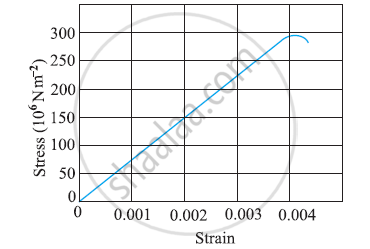Advertisements
Advertisements
Question
A rigid bar of mass M is supported symmetrically by three wires each of length l. Those at each end are of copper and the middle one is of iron. The ratio of their diameters, if each is to have the same tension, is equal to ______.
Options
`Y_(copper)/Y_(iron)`
`sqrt((Y_(iron))/(Y_(copper)`
`Y_(iron)^2/Y_(copper)^2`
`Y_(iron)/Y_(copper)^2`
Solution
A rigid bar of mass M is supported symmetrically by three wires each of length l. Those at each end are of copper and the middle one is of iron. The ratio of their diameters, if each is to have the same tension, is equal to `underline(sqrt((Y_(iron))/(Y_(copper))`.
Explanation:
As the bar is supported symmetrically by the three wires, therefore extension in each wire is the same.
Let T be the tension in each wire and the diameter of the wire is D, then Young’s modulus is `Y = "Stress"/"Strain"`
= `(F/A)/((ΔL)/L)`
= `F/A xx L/(ΔL)`
= `F/(pi(D/2)^2) xx L/(ΔL)`
= `(4FL)/(piD^2ΔL)`
⇒ `D^2 = (4FL)/(piΔLY)`
⇒ `D = sqrt((4FL)/(piΔLY)`
As F and `L/(ΔL)` are constants.
Hence, `D ∝ sqrt(1/Y)`
or `D = K/sqrt(Y)` ......(K is the proportionality constant)
Now, we can find ratio as `D_(copper)/D_(iron) = sqrt(Y_(iron)/Y_(copper)`
APPEARS IN
RELATED QUESTIONS
The figure shows the strain-stress curve for a given material. What are (a) Young’s modulus and (b) approximate yield strength for this material?

Read the following statements below carefully and state, with reasons, if it is true or false
The Young’s modulus of rubber is greater than that of steel;
Four identical hollow cylindrical columns of mild steel support a big structure of mass 50,000 kg. The inner and outer radii of each column are 30 cm and 60 cm respectively. Assuming the load distribution to be uniform, calculate the compressional strain of each column.
Consider the situation shown in figure. The force F is equal to the m2 g/2. If the area of cross section of the string is A and its Young modulus Y, find the strain developed in it. The string is light and there is no friction anywhere.

A truck is pulling a car out of a ditch by means of a steel cable that is 9.1 m long and has a radius of 5 mm. When the car just begins to move, the tension in the cable is 800 N. How much has the cable stretched? (Young’s modulus for steel is 2 × 1011 Nm–2.)
A steel wire of mass µ per unit length with a circular cross section has a radius of 0.1 cm. The wire is of length 10 m when measured lying horizontal, and hangs from a hook on the wall. A mass of 25 kg is hung from the free end of the wire. Assuming the wire to be uniform and lateral strains << longitudinal strains, find the extension in the length of the wire. The density of steel is 7860 kg m–3 (Young’s modules Y = 2 × 1011 Nm–2).
A steel rod of length 2l, cross sectional area A and mass M is set rotating in a horizontal plane about an axis passing through the centre. If Y is the Young’s modulus for steel, find the extension in the length of the rod. (Assume the rod is uniform.)
A boy's catapult is made of rubber cord which is 42 cm long, with a 6 mm diameter of cross-section and negligible mass. The boy keeps a stone weighing 0.02 kg on it and stretches the cord by 20 cm by applying a constant force. When released, the stone flies off with a velocity of 20 ms-1. Neglect the change in the area of the cross-section of the cord while stretched. Young's modulus of rubber is closest to ______.
A uniform metal rod of 2 mm2 cross section is heated from 0°C to 20°C. The coefficient of linear expansion of the rod is 12 × 10-6/°C, it's Young's modulus is 1011 N/m2. The energy stored per unit volume of the rod is ______.
The force required to stretch a wire of cross section 1 cm2 to double its length will be ______.
(Given Young's modulus of the wire = 2 × 1011 N/m2)
